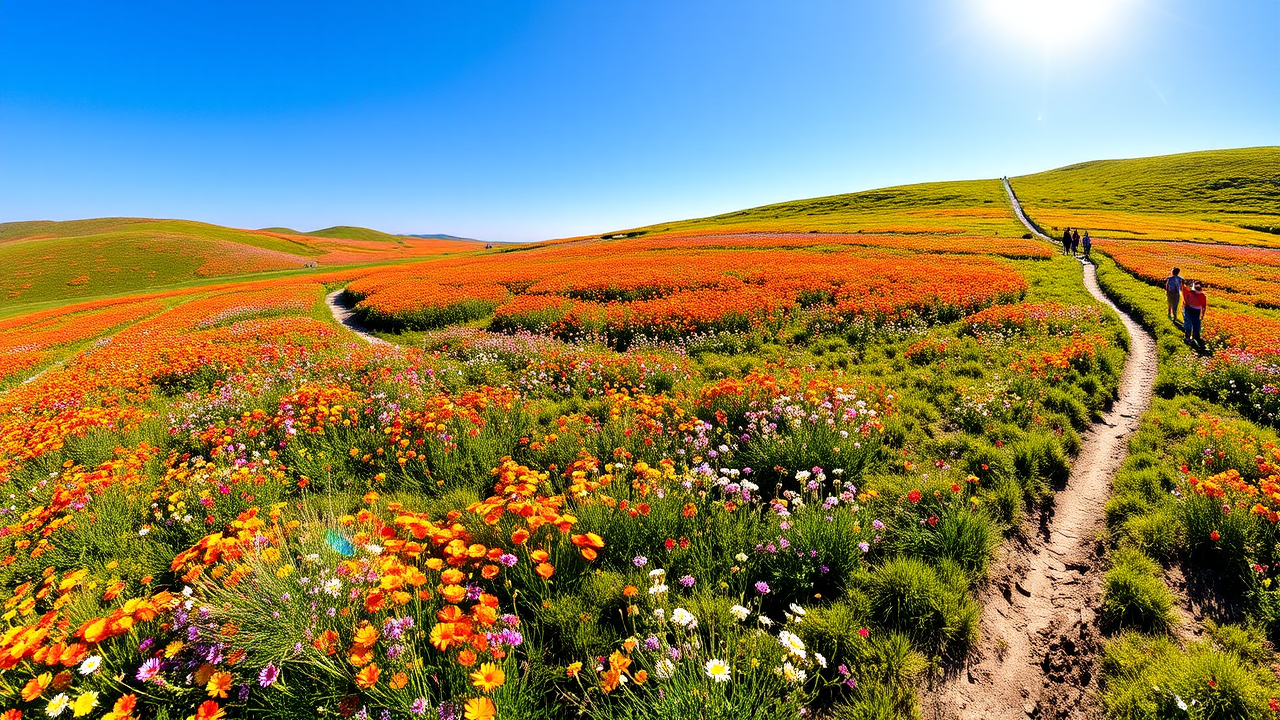# Discover the Vibrant Wildflowers of Your National Parks
Imagine strolling through a scenic landscape where every step reveals a burst of color and intricate shapes—this is the magic of wildflowers in America’s national parks. These protected natural areas are not just home to breathtaking vistas and majestic wildlife but also serve as vital sanctuaries for a dazzling array of wildflowers that paint the landscape throughout the year.
In this post, we’ll explore the significance of wildflowers in national parks, the best times to see them, and why they matter to both the ecosystem and your outdoor experience. Whether you’re a seasoned botanist or a curious traveler looking for inspiration, discovering these blooms is an enriching journey that connects us to nature’s vibrant palette.
## The Diversity of Wildflowers in America’s National Parks
From the delicate blooms of desert landscapes to lush mountain meadows, wildflowers in national parks showcase an extraordinary diversity of shapes, sizes, and colors. Some of the most iconic wildflowers include Colorado’s Indian Paintbrush, California’s California Poppy, and the striking Indian Blanket in the southwestern deserts.
These flowers do more than just beautify the scenery—they play a crucial role in sustaining the ecosystem. They are key sources of nectar and pollen for pollinators like bees, butterflies, bats, and birds. Such interactions are vital for the pollination of many plants, ensuring the continued health and diversity of these environments.
## When and Where to See Wildflowers in Full Bloom
Timing is everything when it comes to catching the best wildflower displays. The seasons vary based on location, elevation, and climate. For example:
– **Spring** (March to May): Many parks burst into color during springtime, with wildflowers such as bluebells, Indian paintbrush, and lupines carpeting valleys and foothills.
– **Summer** (June to August): Higher elevations and cooler regions often see a resurgence of blooms like columbines and sunflowers.
– **Fall** (September to November): Some wildflowers and grasses turn vibrant shades of red, orange, and yellow, creating stunning autumnal landscapes.
To plan your visit, utilize the National Park Service’s [calendar of wildflower events](https://www.nps.gov/subjects/wildflowers/events.htm). Many parks host guided wildflower walks, educational programs, and festivals to celebrate these natural spectacles.
## Why Visiting Wildflower-Rich Parks Matters
Experiencing wildflowers in national parks does more than please the eye; it deepens our appreciation for Earth’s natural heritage and promotes conservation efforts. Wildflowers serve as indicators of environmental health—changes in blooming patterns can signal shifts in climate or ecosystem balance.
Moreover, these blooms attract pollinators, which are essential for maintaining biodiversity and supporting agriculture beyond park borders. By visiting wildflower hotspots, you support park conservation programs and help bring awareness to protecting fragile environments.
## Tips for a Memorable Wildflower Adventure
– **Timing is key**: Check park websites or contact visitor centers for the latest info on peak wildflower season.
– **Stay on designated trails**: Protect delicate plants and avoid trampling blooms.
– **Bring a camera**: Capture the fleeting beauty of wildflowers in their prime.
– **Respect the environment**: Leave no trace to ensure these natural gardens flourish for future visitors.
## Final Thoughts
Wildflowers in national parks exemplify nature’s resilience and artistry, transforming rugged landscapes into vibrant displays of life. By exploring these blooming treasures, we connect more deeply with nature, support ecological health, and discover the simple joy of witnessing the earth’s seasonal renewal.
Next time you plan a trip to a national park, consider the timing and location to witness the breathtaking burst of wildflowers. Whether you’re hiking in the spring or simply observing the fall foliage, there’s always a floral surprise waiting in the wilds of protected lands.
Embrace the natural wonder—go see what’s blooming!
—
# The Role of Wildflowers in Ecosystem Health and Pollinator Support
Wildflowers are more than just eye-catching additions to scenic landscapes; they are foundational to ecosystem health in America’s national parks. These delicate yet resilient plants support a vast array of wildlife, especially pollinators like bees, bats, and birds, which are vital for the pollination process and the overall biodiversity of these protected areas.
## Wildflowers as Pillars of Biodiversity
Each wildflower species plays a specific role within its environment, providing food and habitat for insects, animals, and microorganisms. The presence of diverse wildflowers ensures a balanced ecosystem, supporting species that rely on particular plants for survival. For example, certain butterflies depend on specific wildflowers for their larval stages, highlighting the interconnectedness of flora and fauna.
## Pollinator Conservation and Wildflowers
Pollinators are essential for not only wildflower reproduction but also for agriculture and biodiversity beyond park borders. However, many pollinator populations face threats from habitat loss, pesticides, and climate change. Wildflowers in national parks serve as critical refuges, offering a safe haven where pollinators can forage and thrive.
By restoring and maintaining native wildflower populations, parks help bolster pollinator health, which, in turn, benefits ecosystems, food security, and biodiversity worldwide.
## How You Can Help
Visiting wildflower-rich parks and supporting conservation programs are excellent ways to contribute to pollinator health. Keep in mind:
– **Avoid disturbing wildflowers**—observe and photograph rather than pick.
– **Support native plant growth** in your own garden by planting wildflowers indigenous to your region.
– **Participate in volunteer programs** that involve planting and maintaining native wildflower habitats.
## The Science and Future of Wildflower Preservation
Scientists continuously monitor blooming patterns and plant diversity to understand climate change impacts. As global temperatures shift, wildflower blooming times may change, affecting pollinator interactions and ecosystem stability. Protecting wildflower habitats and promoting native plants are vital strategies for climate resilience.
## Conclusion: Celebrating the Natural Pollinators and Wildflowers
Wildflowers are more than just beautiful blooms; they are guardians of ecological health, supporting pollinators and maintaining the delicate balance of ecosystems within national parks. As visitors, we have the power to appreciate, protect, and promote these vital plants for generations to come.
Next time you’re exploring a park, take a moment to notice the wildflowers—not just for their beauty but for their role in sustaining life on Earth. Supporting native wildflowers and pollinators ensures that future generations can also enjoy the rich tapestry of colors and life in our national parks.
—
# Wildflower Festivals and Events: Celebrating Nature’s Artistry
Attending wildflower festivals and special events can greatly enhance your experience exploring America’s national parks. These gatherings celebrate the seasonal bursts of color, promote environmental education, and foster a deeper connection between visitors and the natural world.
## Why Attend Wildflower Events?
Wildflower festivals are more than just outings—they are opportunities to learn about native plants, conservation efforts, and the importance of pollinators. Attendees often enjoy guided walks, expert talks, workshops on native gardening, and opportunities to photograph these fleeting natural displays.
Participating in such events supports local communities and park initiatives dedicated to conserving wildflower habitats and promoting sustainable outdoor recreation.
## Popular Wildflower Festivals Across the U.S.
While many parks host their own celebrations, some notable wildflower festivals include:
– **Antelope Valley California Poppy Festival**: Celebrates the blooming of California’s state flower with art, music, and educational exhibits.
– **Great Smoky Mountains Wildflower Pilgrimage**: Offers guided walks, plant identification classes, and lectures emphasizing native plants and ecosystems.
– **Colorado Poppy Day**: Focuses on the vibrant native poppies, including guided hikes and photography contests.
Check your local national parks’ event calendars for upcoming festivals or wildflower walks. Many are seasonal, coinciding with peak bloom times, so planning ahead ensures you won’t miss these colorful celebrations.
## Tips for Enjoying Wildflower Events
– **Arrive early**: Popular events draw many visitors, especially during peak blooming season.
– **Wear comfortable clothing and sturdy shoes**: Some activities involve light hiking or walking on uneven terrain.
– **Bring your camera**: Capture the stunning displays of color.
– **Participate actively**: Join guided tours, ask questions, and learn from park rangers and botanists.
– **Be environmentally conscious**: Follow Leave No Trace principles to protect fragile blooms and habitats.
## How Wildflower Festivals Inspire Conservation
These festivals serve more than festival fun—they inspire conservation initiatives by raising awareness of native plants and pollinator health. They often feature workshops on native plant gardening, encouraging visitors to cultivate wildflowers at home, which supports local pollinators and reduces habitat fragmentation.
## Final Thoughts
Wildflower festivals and events are perfect opportunities to immerse yourself in nature’s artistry while supporting conservation. They foster community spirit, education, and a profound appreciation for the intricate beauty of America’s wildflowers.
Next time you plan a trip to a national park, look out for seasonal wildflower celebrations. Whether you’re a photography enthusiast, a family picnic-goer, or a nature lover, these events are a delightful way to connect with the natural world and celebrate the fleeting, enchanting beauty of wildflowers.
—
# Planning Your Wildflower Viewing Trip in a National Park
Thinking about exploring America’s breathtaking national parks during the wildflower season? Planning ahead can transform your visit into an unforgettable experience, allowing you to witness the most spectacular blooms and immerse yourself in nature’s vibrant canvas.
## Best Practices for Planning Your Wildflower Adventure
### 1. Research Bloom Peak Times
Wildflower blooming varies by region and elevation. Typically, spring (March–May) and early summer (June) are prime times, but high elevations or specific parks may have different peak periods. Use reliable resources like the [National Park Service wildflower calendar](https://www.nps.gov/subjects/wildflowers/events.htm) to find current info.
### 2. Choose the Right Park
Some parks are renowned for their wildflower displays, such as:
– **Great Smoky Mountains National Park** in Tennessee and North Carolina
– **Colorado National Monument**
– **Death Valley National Park** in California
– **Shenandoah National Park** in Virginia
Select a park that matches your interests, whether mountain meadows, desert blooms, or forest wildflowers.
### 3. Plan Your Hikes and Walks
Many parks offer designated wildflower trails or guided walks. Check park maps and schedules to find suitable routes for your fitness level and interest. Early morning or late afternoon are ideal times for viewing, as flowers often open and close with the sun.
### 4. Prepare Your Gear
Bring essentials:
– Good hiking shoes
– Camera with macro lens for close-up shots
– Binoculars for observing pollinators
– Sun protection and insect repellent
– Water and snacks
### 5. Respect Nature and the Environment
Stay on designated trails, avoid picking flowers, and pack out all trash. Protect delicate blooms and habitats for future visitors.
## Enhancing Your Experience
– **Join guided tours or ranger programs** to learn about native plants and pollinators.
– **Bring a field guide** or plant identification app to help identify various species.
– **Capture the moment** with photos but do so responsibly—avoid trampling or disturbing the flowers.
## Supporting Wildflower Conservation
Your visit can contribute to conservation awareness. Consider planting native wildflowers in your garden or supporting local conservation organizations that protect native habitats.
## Final Thoughts
With thoughtful planning, your wildflower viewing trip can be a rewarding adventure full of color, learning, and connection to nature. These moments not only beautify your memories but also deepen your appreciation for the intricate web of life that wildflowers support.
Get your cameras ready, check the bloom calendars, and set out on a journey to witness nature’s fleeting masterpieces in America’s national parks!


Leave a Reply
You must be logged in to post a comment.